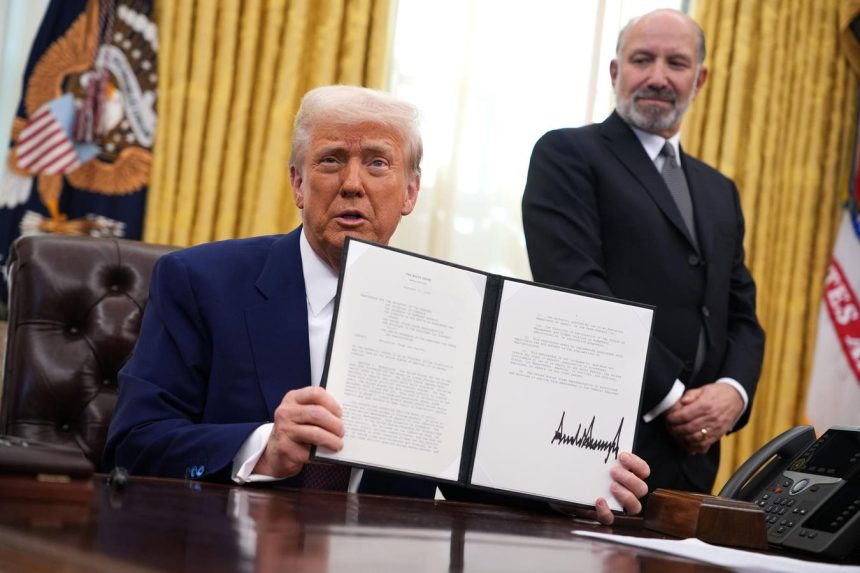U.S. stocks declined as President Trump’s tariffs against Mexico, Canada, and China are set to take effect at midnight. While there has been much debate over the wisdom of Trump’s tariff policy, the issue goes much deeper than inflation. Timely tariffs can have a noticeable impact on the financial health of the U.S. For example, imports and exports create a trade deficit or surplus, which affects the amount of U.S. debt and property owned by foreign entities, which in turn affects the federal government’s financial strength. I’ll explain that in a moment. Tariffs, under the right circumstances, are a viable tool to strengthen U.S. businesses, the labor market, wages, and more.
Trump’s Tariffs: Imports and Exports
While tariffs often raise the price of imported goods, triggering inflation, whenever goods flow from one country to another, money also exchanges hands. When America imports more than it exports, more money leaves the U.S. than enters the country. When imports exceed exports for an extended period, foreign entities receive more money, and the U.S. receives less. Foreign entities use this surplus of money to invest, much of it back into the U.S. You might think that’s good, and it is to some extent. However, it also increases the amount of property, business interests, securities, etc., owned by foreign interests. Thus, a prolonged trade deficit becomes a means of transferring wealth to entities outside the U.S. The following chart contains U.S. exports and imports from January 1, 1947, to October 1, 2024.
Notice how imports (orange line) have exceeded exports (blue line) for decades. Again, much of this outgoing money is reinvested in the U.S., some in U.S. Treasuries. The U.S. is highly dependent on investment in Treasuries to pay for its fiscal deficits, which last year reached a whopping $1.8 trillion. According to the Department of Treasury, net interest on America’s $36 trillion debt was the third largest budget item during the most recent fiscal year ending September 30, 2024. Net interest paid on the debt was $882 billion, slightly less than health costs ($912 billion) and Social Security ($1,461 billion), but more than Medicare ($874 billion) and national defense ($874 billion).
As the trade deficit expands to a near-record level, the national debt has expanded as well. The following chart shows America’s trade deficit or surplus in each fiscal year as a percentage of GDP back to January 1966, along with the national debt. There were only two periods when the trade deficit was positive, meaning, the U.S. sold more goods than it bought. One period was back in 1975, and the other was 1980-82. Both times, the U.S. was in recession. Why are trade deficits a problem and what does it have to do with tariffs? Stay with me. We’re almost there.
As mentioned, when the trade deficit expands, foreign entities use the money to invest. Much of it is invested in American businesses, land, government Treasuries, and more. China, the world’s largest exporter, will use some of the money collected from goods sold to the U.S. to buy U.S. interests. If this trend continues, China’s ownership in America will increase. In a real sense, China is gaining control over America without firing a shot. Thus, the current trend cannot continue.
Trump’s Tariffs: Purpose and Plan
Tariffs can be a great equalizer for U.S. businesses. Tariffs increase the price of imported goods, which helps U.S. businesses compete. Yes, consumers will pay more, but that may be a short-term problem. Why? Because as foreign exporters sell less to the U.S., they may reduce their tariffs on goods they import from America. Overall, tariffs can result in lower prices all around if foreign nations allow more U.S. good to be sold in their country. When more U.S. goods are sold abroad (and at home), American businesses thrive and hire more workers. In short, it can bring greater prosperity to the America. Tariffs may also boost wages in the U.S. as businesses prosper. Of course, technology has the opposite effect on workers as A.I. and robotics replace portions of the workforce. But technology can also make it cheaper to produce goods. We’ll have to wait and see which has the greater affect.
Trumps Tariffs: Trade War or Not?
Some suggest Trump’s tariffs will create a trade war. I don’t believe it will. Why? Let’s look at the Smoot-Hawley Tariff Act of 1930. The U.S. was in a depression when Congress passed the bill and Hoover signed it into law. Back then, it did create a trade war. Many economists believe it prolonged the depression. At that time, the U.S. had a trade surplus. That’s not the time to enact tariffs. Tariffs work best when there is a trade deficit, as there is now. Therefore, I think a trade war is unlikely, especially since the U.S. is the largest consumer on the planet and foreign nations need to do business with America.
The U.S. has been importing more than it sells for decades, which has had the effect of transferring American wealth abroad. Tariffs can be a part of the solution. I didn’t address the 25% tariff on Mexico and Canada in this article, but did so in a recent article entitled, Trump’s Tariffs And Inflation – Who Pays?
Will Trump’s tariffs work? There will be some short-term pain, but if we do nothing and continue down this same road, we will eventually have to deal with America’s fiscal crisis at some point, and the pain will be much greater the longer we wait. Therefore, it is best to address it now. Stay tuned.
Read the full article here














